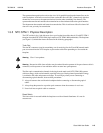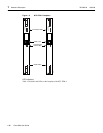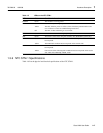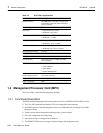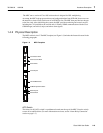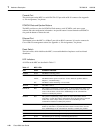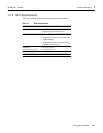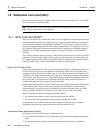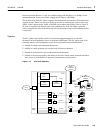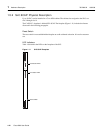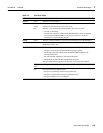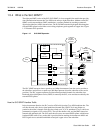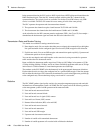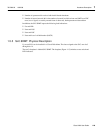
1 Hardware Description 78-5296-02 10/02/98
Cisco 6200 User Guide1-22
1.5 Subscriber Line Card (SLC)
This section describes the CAP and DMT versions of the subscriber line card (SLC). A Cisco 6200
chassis can hold up to 10 SLC modules.
Note All the SLCs in a Cisco 6200 chassis should be of the same type. The mixture of CAP and
DMT cards in a single chassis is not supported.
1.5.1 What is the SLC 8CAP?
The CAP version of the SLC (labeled SLC 8CAP) is a hot-swappable line module that provides data
communication between the Cisco 6200 node and up to eight subscribers. Modems on the CAP SLC
use the carrierless amplitude modulation/phase modulation (CAP) method, a common line code
method for asymmetric digital subscriber line (ADSL) transmissions. As an ADSL device, the CAP
SLC transmits high-speed data through an external plain old telephone service (POTS) splitter to
subscribers over existing, telephone-grade segments of copper wire. Figure 1-10 illustrates SLC
operation.
The CAP SLC transports data at speeds up to 7 Mbps downstream (from the service provider to the
subscriber) and receives up to 1 Mbps upstream (from the subscriber to the service provider). The
SLC supports upstream and downstream passband channels for subscriber data. Baseband POTS is
unused by the SLC; data is added to this channel by the external POTS splitter.
How the SLC Handles Traffic
In the downstream direction, the SLC receives ATM cells from the Cisco 6200 backplane bus. The
cell filter discards cells whose virtual path/virtual channel IDs (VPI/VCIs) do not pertain to this
subscriber’s channel. (Each port has a fixed set of 31 VCIs, which are permanently assigned to VCIs
on the NTC.) The traffic controller buffers cells. Then the CAP transceiver transmits the outbound
cells. The SLC sends the cells out to an external POTS splitter, which inserts baseband POTS traffic
(if any such traffic is provided) before sending the downstream ADSL and POTS signals across
standard unshielded twisted pair copper wire to the subscriber.
In the upstream direction, the SLC receives ADSL signals from a POTS splitter and demodulates the
CAP-modulated signal. Then the SLC channel contends with the other SLC channels for the
upstream data bus. Two priority levels are available. For the first Cisco 6200 release, only UBR
service is available. The SLC will ensure fair access among all cells of the same priority.
The SLC separates the upstream and downstream data channels:
• The upstream data channel occupies a band between 30 kHz and 200 kHz.
• The downstream data channel takes the band between 240 kHz and 1.5 MHz.
At the subscriber site, the DSL customer premises equipment (the Cisco 675, for example)
demodulates the downstream signal and sends the data to the subscriber’s PC.
Transmission Rates and Modem Training
Two options are available with respect to transmission rates:
• You can set the subscriber ports to rate-adapt (train) automatically to the highest attainable line
speed.
• You can set transmission speeds. Upstream and downstream speeds can be set separately.




